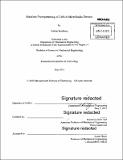| dc.contributor.advisor | Anastasios John Hart. | en_US |
| dc.contributor.author | Spielberg, Nathan (Nathan A.) | en_US |
| dc.contributor.other | Massachusetts Institute of Technology. Department of Mechanical Engineering. | en_US |
| dc.date.accessioned | 2015-09-17T19:10:20Z | |
| dc.date.available | 2015-09-17T19:10:20Z | |
| dc.date.copyright | 2015 | en_US |
| dc.date.issued | 2015 | en_US |
| dc.identifier.uri | http://hdl.handle.net/1721.1/98762 | |
| dc.description | Thesis: S.B., Massachusetts Institute of Technology, Department of Mechanical Engineering, 2015. | en_US |
| dc.description | Cataloged from PDF version of thesis. | en_US |
| dc.description | Includes bibliographical references (pages 91-92). | en_US |
| dc.description.abstract | Upon examining current methods for printing and patterning of live biological cells, there is a need for a method capable of printing with the resolution of single biological cells to organize them into complex structures. In order to fill this need, building upon previous design of a dynamic lithography system, a stop flow lithography system was implemented capable of patterning individual particles with a mean accuracy of 11.92 [mu]m and a standard deviation of 4.63 [mu]m. This was achieved by improving the tracking capability of the software by measuring the exposure vs velocity relationship to anchor the particle as well as implementing a stop flow lithography based software approach. With the goal of producing 3D functionalized tissue, a 3D printing module was constructed for the dynamic lithography system that constructed microscale parts with a minimum layer height 16.42 [mu]m of and planar resolution of 10 [mu]m, comparable to the top available micro-scale 3D printers. To push the capability of the system, I analyzed and presented the limitations of the process via an opto-thermal model, and a computational fluid dynamics model which is then studied through a previously developed throughput analysis to get a theoretical maximum output of the system. In analyzing the limitations of the printing process, maximum input optical system power was characterized, and a theoretical maximum system throughput of 10,000 particles per second was calculated. This work is a step towards voxel based multimaterial printing, leading to printing of living artificial biological organs, better organs on a chip, or even bionic implants that combine electrical and biological elements. | en_US |
| dc.description.statementofresponsibility | by Nathan Spielberg. | en_US |
| dc.format.extent | 92 pages | en_US |
| dc.language.iso | eng | en_US |
| dc.publisher | Massachusetts Institute of Technology | en_US |
| dc.rights | M.I.T. theses are protected by copyright. They may be viewed from this source for any purpose, but reproduction or distribution in any format is prohibited without written permission. See provided URL for inquiries about permission. | en_US |
| dc.rights.uri | http://dspace.mit.edu/handle/1721.1/7582 | en_US |
| dc.subject | Mechanical Engineering. | en_US |
| dc.title | Maskless photopatterning of cells in microfluidic devices/ | en_US |
| dc.type | Thesis | en_US |
| dc.description.degree | S.B. | en_US |
| dc.contributor.department | Massachusetts Institute of Technology. Department of Mechanical Engineering | |
| dc.identifier.oclc | 920901771 | en_US |
